|
|||
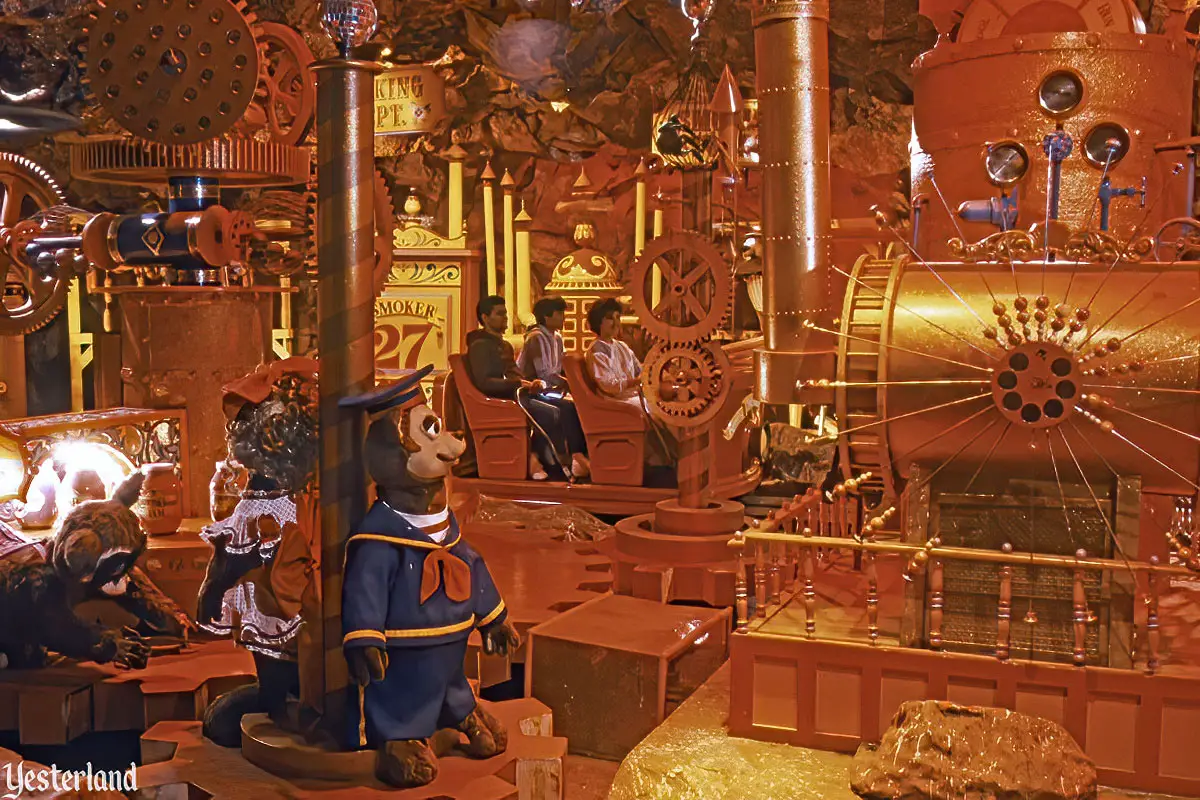
Courtesy of the Orange County Archives, from the Knott’s Berry Farm Collection |
|||
|
Disney Legend Rolly Crump died yesterday at age 93. Crump is best known for his whimsical, stylish, and clever design contributions to such Disney attractions as the Haunted Mansion, “it’s a small world”, and Walt Disney’s Enchanted Tiki Room. Many of us also fondly remember a ride that he designed for Knott’s Berry Farm: Knott’s Beary Tales. Chris Merritt is a theme park designer, theme park historian, and co-author of a wonderful book about the history of Knott’s Berry Farm, Knott’s Preserved. In 2001, Merritt interviewed Crump while doing research for that book. Merritt kindly allowed me to publish that interview. After I learned of Crump’s passing, I reread it. I think you might enjoy it too. So here it is again, with larger, better images.
|
|||
|
|
|||
|
Rolly Crump has had a long and colorful history in the world of theme park design. His career began with Disney, animating the classic Peter Pan. By the late 1950s, he had moved to W.E.D. (today known as Walt Disney Imagineering) to do model work on a proposed Wizard of Oz attraction. Although Oz never saw completion, he had his hand in other major Disneyland attractions—such as the Enchanted Tiki Room and the Haunted Mansion. His most recognizable work is the whimsical façade he designed for the “it’s a small world” attraction’s new home at Disneyland after the 1964 World’s Fair. In the early 1970s, Rolly temporarily left W.E.D. for freelance work. While at work in Florida, for an unfinished theme park—Circus World—he was asked by the Knott family to further develop Wally Huntoon’s idea for a “gypsy dark ride.” Rolly’s ideas went through many different character approaches—but kept with the underlying idea of a “journey to the fair,” now taking place during the Roaring 20s era. The attraction evolved into a total “Crump” experience. Anyone familiar with his sense of humor and design would recognize his styling throughout the ride. CHRISTOPHER MERRITT: Rolly, can you begin by telling us when you were first approached to work on a dark ride for Knott’s? ROLLY CRUMP: Sure. I think it was September of 1974. Actually, the fellow that contacted me was named Dick—he had been a controller for Disney, and then went to Knott’s. And evidently he and Marion Knott decided that they wanted to do a dark ride. I guess he’d told Marion that I was no longer with Disney and that they should contact me. But, I had been in Florida at work on Circus World for a year. When I decided to come back, they contacted me, so I went down and met with them. |
|||
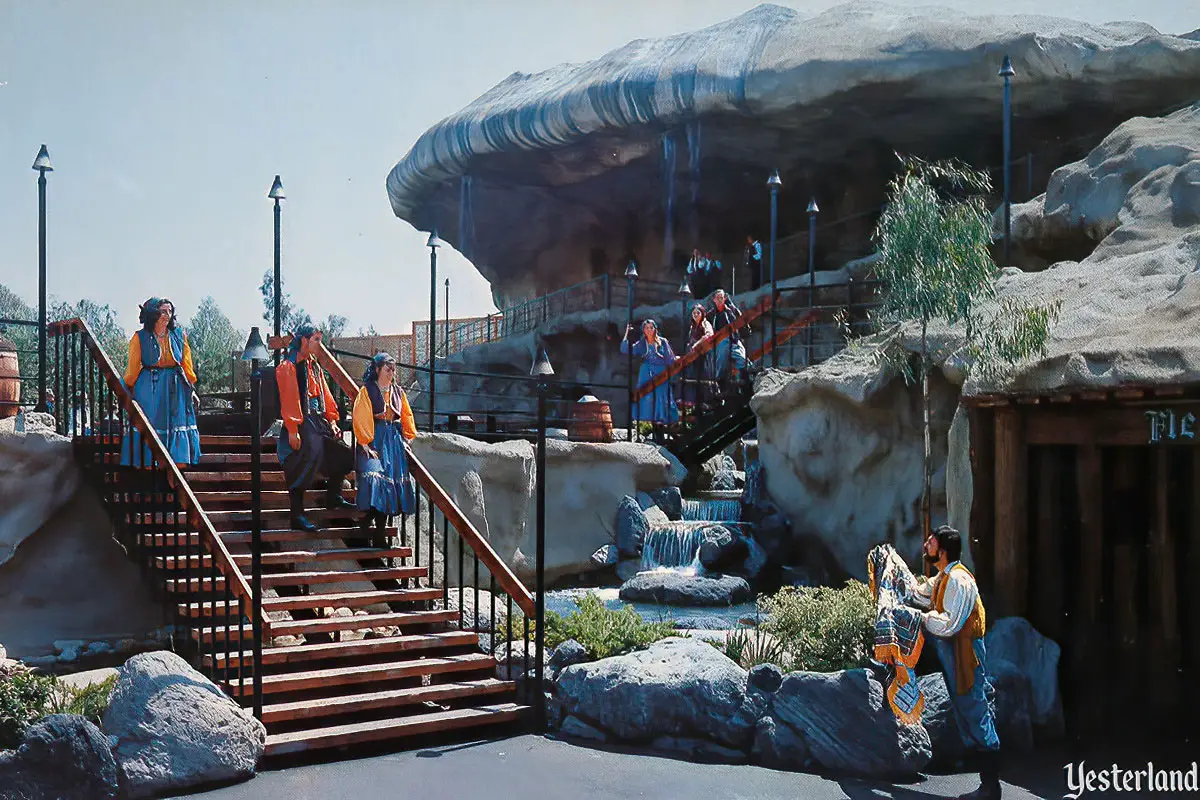
Courtesy of the Orange County Archives, from the Knott’s Berry Farm Collection Gypsy Camp at Knott’s Berry Farm, which needed an attraction. |
|||
|
CM: What happened then? RC: Well, first of all, it wasn’t a Roaring 20s area when we started it. There was a young fellow there (Wally Huntoon) that had an idea for a dark ride that would be located in the Gypsy Camp. Marion gave me the script he had written—it was a story about a little boy and his donkey going off to the fair, and then along the way, the adventures that he ran into. But, it was just kind of an outline, so I began to embellish it. I don’t know much about that area, other than the fact that there was a huge building it was built in, that had been there for gaming. They had a lot of computer games and such—they had I don’t know how many feet of games! So, this started off being a gypsy ride. Then, it was later that they decided to develop a much larger area—and at the last minute, they decided to call it the Roaring 20s! So, it was an evolution... CM: So, did you then begin work on the ride? RC: Actually, there was a lot that went on between that! What happened was that I had to make a presentation to the Knott family—of what the ride would be. So, I did a lot of sketches, layouts and some story ideas. Walter Knott was still alive at that time, and I gave the whole presentation to the Knott family. Marion, her brother and her two sisters with their husbands. So, once I gave the presentation to them, they decided to give me the green light and go with it. Once they did that, that’s when I contacted Tom O’Neil—who had a company called Fantasy Fair. He was down on Santa Monica Boulevard in Hollywood. And I just went up to Tommy and said, “I’ve got an opportunity to do a dark ride for Knott’s Berry Farm. Would you like to build it?” And he said, “Oh god Rolly, that sounds great!” The way I met Tom was, he did all the animated window displays for Disneyland back in the 60s and 70s. And every time they would release a feature cartoon, they would dress the windows. So, I knew that he had a good understanding of fantasy and he did have a certain understanding of mechanical devices. I knew that we couldn’t get anywhere near the animatronics of Disney, and I felt that we couldn’t get that complicated with the ride. So, we started developing it, and I introduced Tom to Dick and Marion. And he sat down and gave them a budget. It was kind of interesting, because when he first looked at what we were going to do—I kind of took him through the ideas. I just basically talked it—I didn’t show him any sketches or anything. And I said, “Tommy, we need to put a budget together on how much it will cost to install it.” And Tommy immediately went home with a migraine headache! He called me back the next day and said, “Well, I’ve worked out a good number. I think it looks like $600,000.” And I said, “No, Tommy, I think it’s more like $900,000.” So, we set the budget at 9—it would have never made it at 6. CM: That’s not very much… RC: Well, I enjoyed working with Marion! I mean, Knott’s had built an incredible park over the years. Walt Disney used to go to Knott’s Berry Farm and he got a lot of his ideas for Disneyland from Knott’s. Anyway, when I met Marion, I was very excited to work for them because…God! I had grown up with Knott’s since I was 9 years old! I remember when it really was a farm! I even remember before the Ghost Town, when my grandfather would take us down there for the chicken dinner and boysenberry pie. So, when I met Marion, we got to be real close friends and she told me some interesting stories about when she was a little girl. She was telling me that they used to have a fruit stand, and her dad would make her stand out there holding a stalk of rhubarb and wave it at all the people going by! (LAUGHTER) |
|||
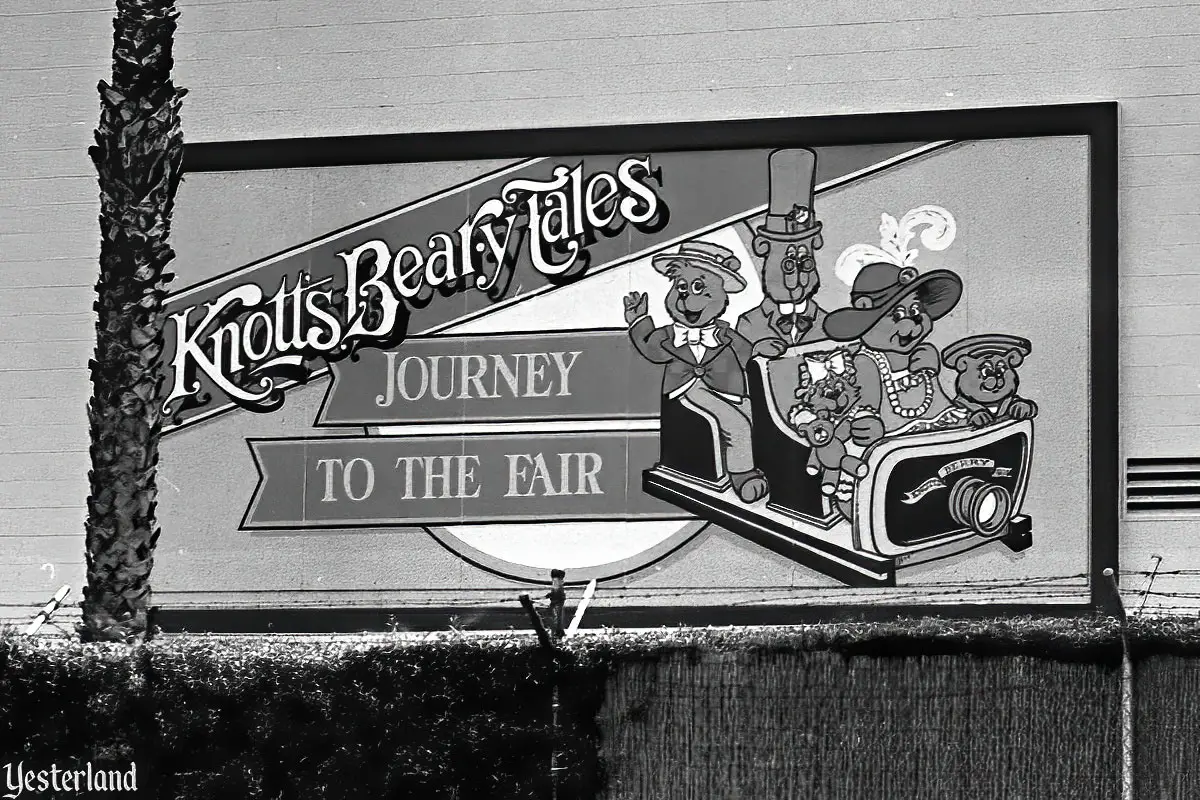
Courtesy of the Orange County Archives, from the Knott’s Berry Farm Collection Billboard on the back of the Knott’s Bear-y Tales, facing Western Avenue |
|||
|
CM: Let’s get into the storyline of Bear-y Tales. Can you tell us about the evolution of that? RC: Sure. We decided that the idea of going to a gypsy fair was a really fun idea. And we thought that once you got on the conveyance, you would be on the way to a fair. So, we stayed with the gypsy idea, since it was going to be in the Gypsy Camp. Originally, all my sketches were of humans for this. And, you would meet various gypsies here and there. During this time is when we came up with the idea of the Frog Forest, and then came the Fortune Teller Camp. Well, some of the sketches I had done showed the gypsies dancing with bears—and everybody really liked the bears! Then, they brought in an outside marketing firm to market the ride. They wanted to test it and find out if the public liked the idea, which I did not agree with. I said, “You know, Walt Disney never test marketed anything. If he felt it was a good idea, he just went ahead and did it.” CM: So, it just evolved into a show with animals as the gypsy stand-ins? RC: Yes. Then they brought some people in, showed them some of the artwork—and what came out of it was probably a good idea. I mean the fact that everybody really liked the animals. So, while we were in the process of putting in more animals, that’s when we came up with the idea of the “Knottsenbear-y” family. That’s where the Factory came in—y’know, juices, jams and stuff. See, Tommy O’Neil was in production of the characters and sets already. Well, during this time, Marion came in and said, “I’d like this to be a western ride.” So, all of a sudden, I had to start redrawing the characters like cowboys! I think she also wanted it in a Gold Mine. Well, I barely got some cowboy hats on the frogs, when she decided to go back with the gypsy idea. |
|||
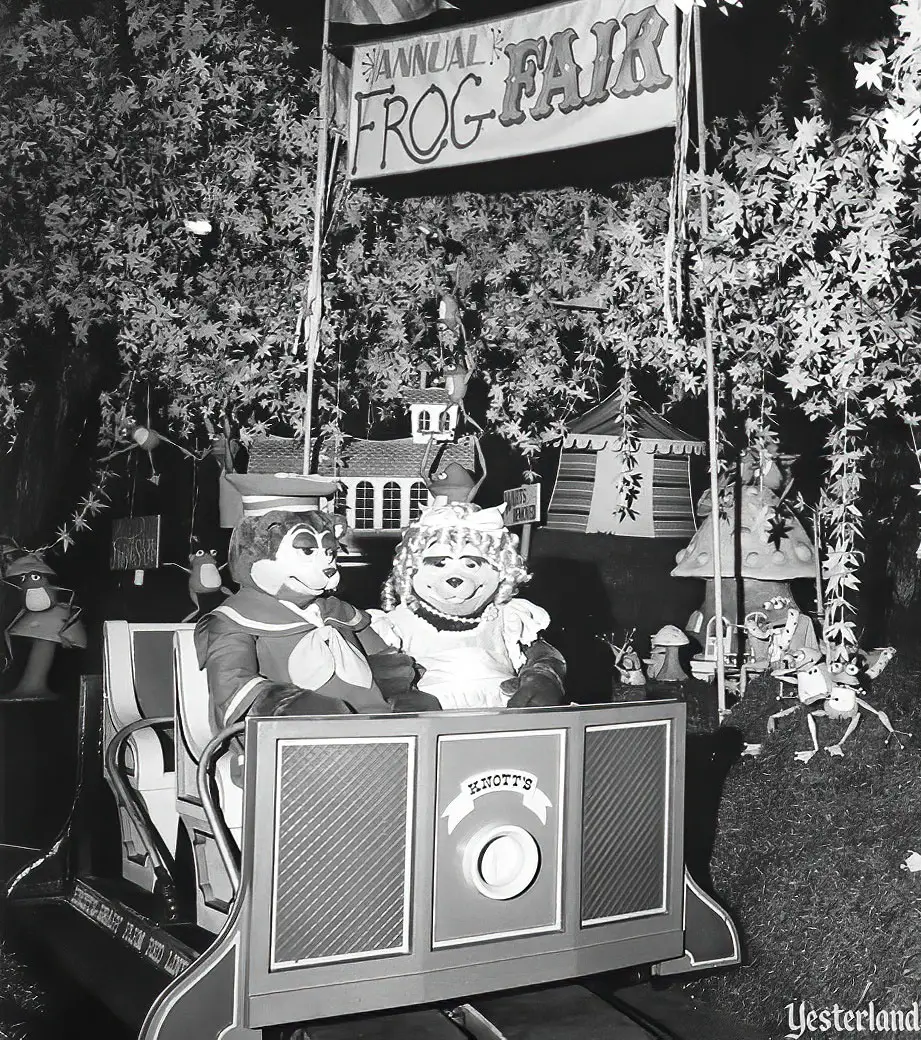
Courtesy of the Orange County Archives, from the Knott’s Berry Farm Collection Rolly Crump’s frogs in the Frog Fair |
|||
|
CM: Quite a few people have fond memories of those frogs… RC: Yeah, me too! So, then is when we turned all the characters into animals. That’s what happened with the Chug-A-Chug machine, all the stuff with the little bears going, you went into Frog Forest and the Fortune Tellers. Then down the tube into the Weird Woods and everybody kinda came together at the County Fair. And the reason for that steep decline in the Spider Tunnel to Weird Woods—was designed because the original concept was that you would have a free fall. The cars would climb to the top, and then it was released like a roller coaster! You’d have a free fall down into Weird Woods. There were talks with Arrow development, but eventually we went with a fellow who had a business that made equipment to take cars through, to move things… CM: Similar to the Ford Magic Skyway at the ‘64 World’s Fair? RC: Exactly. So, because of that—plus the fact that this man was a lot cheaper than Arrow! Of course, the reason Arrow was more was because we had the free fall! CM: Why a free fall in such a slow ride, with so much to see? RC: Well, what happened was—at the top there was this pretty good-sized space that we didn’t know what to put in there. We were just gonna make it black—like all of a sudden you’d dropped down a black hole. And all that rockwork was done with Pyre-Cure paper—it’s a paper they use for insulation on roofs, and it’s flame proof. On the back, it’s shiny like tin foil, and on the front it’s just kind of a natural color. It’s got all kinds of soft mesh wire in it, so you can shape it and it will hold. So, that’s how we made our rockwork. Well, what I did was put it in reverse in the cave, so it was all shiny! So, it was like you were in this crinkled, shiny cave—and then we shot off strobes in there! This was weird, but I did it for a reason. See I wanted you to really screw up your eyes again, so they would close up on you. So, when you hit Weird Woods, you couldn’t see very well—because your iris would be opened up! I was really trying to screw up your eyes in that sequence. CM: So, after all the previous character changes, you finally went with the Roaring 20s? RC: Yes, Marion finally decided to go 20s. That’s why in the finale, they’ve all got straw hats, etc… But the reason that it worked, was that we stayed with fantasy. It was like looking at a children’s book, and all the animals you’d encounter on the way to the fair. So, we just went straight ahead with the characters once we got going—it was easy to change the clothing and style of costumes. Y’know, I ended up doing a caricature of Marion—I gave her clothing that was part gypsy, part cowboy and part Roaring 20s—and I had her waving a stalk of rhubarb! I also drew some Chinese stuff on her, and I wrote, “Well Marion, we’ve been through gypsies, cowboys and Roaring 20s—before you’re finished, I’m sure you’ll want to make this a Chinese ride!” (LAUGHTER) So, she took it in good stride, and actually had it hanging up in her office for a while! |
|||
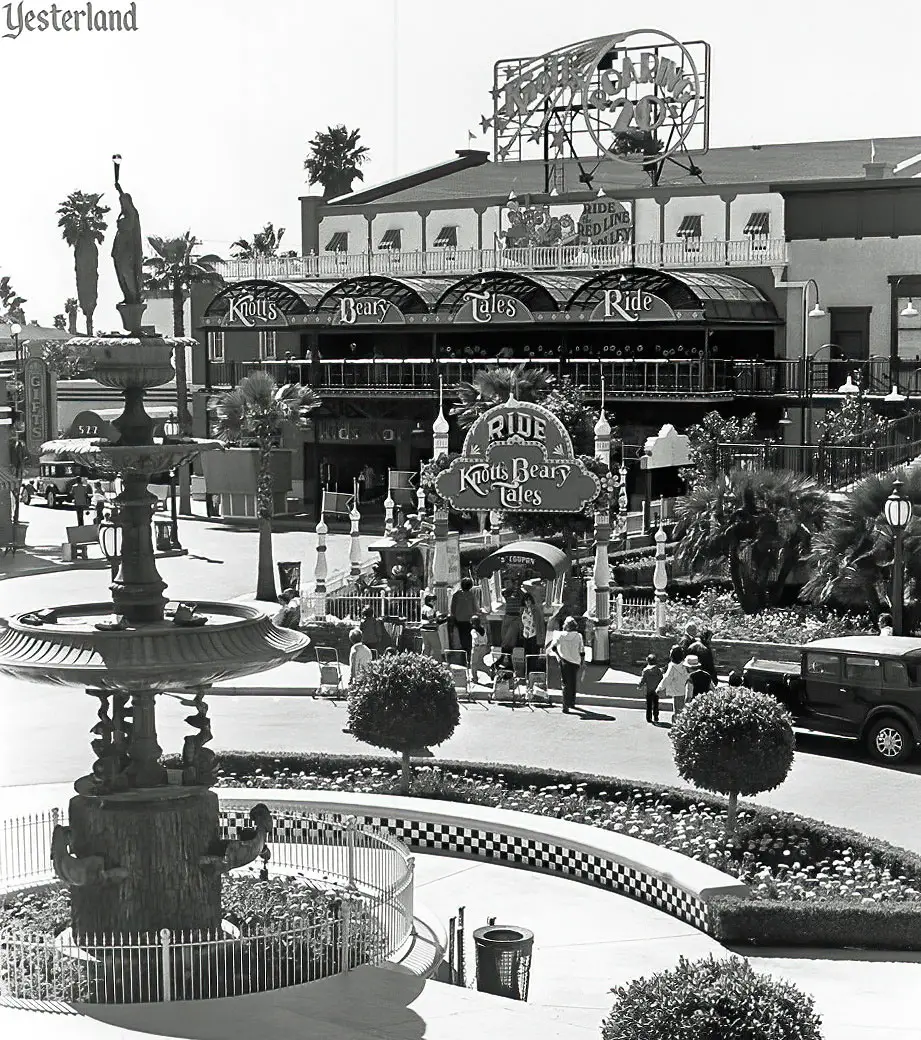
Courtesy of the Orange County Archives, from the Knott’s Berry Farm Collection Part of the Roaring 20s themed area, which opened in 1975 |
|||
|
CM: Why was the ride placed up on a second level? RC: Well, that’s the space that was given to us—for some unknown reason, they decided that’s where the ride was going to go. It’s where the Gypsy Camp was originally, but they moved all that downstairs. So, we had a pretty good size—I think close to 20,000 feet. It was a fairly big sized ride. CM: The mural in the load area is something that many people have enjoyed and remembered. Who painted that? RC: Well, Suzie McLean did all that. She and I sat down together, and used the same formula that Disney used on the dark rides at Disneyland. The idea being that the mural is kind of a story of what’s going to happen to you once you got on this ride. Because, we had a huge wall to cover (and Suzie did a magnificent job on it)! She’s an incredible designer. I got her to come work with me at Design 27 when she was still in high school! She had been dating my partner’s son and he said, “ Oh my son’s got this girlfriend that’s a pretty good artist.” And I thought, “Oh boy…” (LAUGHTER) So, they brought her over here one time and she was very enthusiastic—I had her do a few sketches, and I was really blown away by her. So, we brought her in on a part-time basis, and finally full-time. I think that was about 1971. CM: What was Design 27? RC: Oh, it was my company in Newport Beach. After I left Disney in 1970, I had a partner named Ernie Ball—he and I formed this design firm. CM: Suzie did all the wanted posters too? RC: Yes, she did all of those as well as laying out all the signs in the ride! Then she got a job at W.E.D. as a graphics designer for a while. |
|||
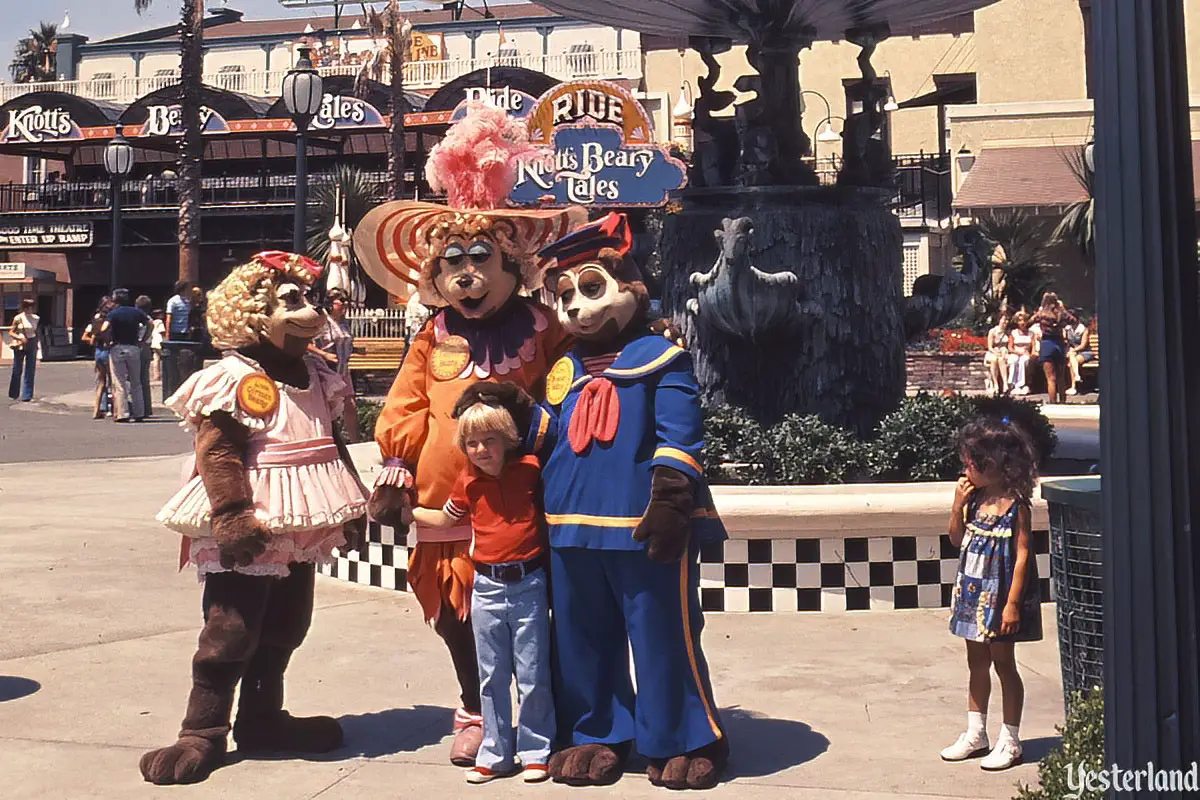
Courtesy of the Orange County Archives, from the Knott’s Berry Farm Collection Girlsen Bear-y, Flapper Bear-y, and Boysen Bear-y posing with a guest |
|||
|
CM: One of my most vivid memories is the overwhelming “berry” smell in the Factory. Who came up with that? RC: That was my idea. I got that from the Log Ride at Knott’s. Every time you went through the flume, you could smell pine trees—and I thought you were smelling the real trees! They said, “No. That’s just some aerosol cans.” And I said, “God—can we get that in the smell of sweet berries?” And they said, “Sure.” So I put that in there. CM: The Bear-y Tales is one of only a few dark rides that I can think of to mix black light with incandescent. Was that an innovation for you? RC: Well, I had tried to do that for Walt Disney World—I wanted to mix the two. But management at that time still believed that, “If it’s a dark ride, it should only be UV lighting.” And I said, “Well, I think you can get much more of a fantasy feel if you go the other way.” And the funny thing about this was, where I got the idea was the wax museum in Buena Park! This was in the early 60s—I went to the museum and Count Dracula was lying in his coffin. And of course, the whole wax works is incandescent lighting. Except where he was lying in the coffin—they had black light on him! To, y’know—make him seem eerie looking. And I stood there looking at this combination, and said, “That’s really great.” My idea was that you want to get your eyes accustomed to the light. A lot of the time in a line for a dark ride if you stand out in the sun too long, your eyes don’t have a chance to open up. When you get in the ride, you don’t see anything for the next 30 seconds! Well, some dark rides are only 90 seconds long! What I decided was to do incandescent in the Factory. Then, when you got to Frog Forest, to go to black light, but using incandescent light on the water (because water doesn’t sparkle very well under UV lighting). Then, complete UV in the Fortune Teller Camp, and also 100% black light in the Weird Woods. Then, the Fair was 50/50. And all the backgrounds and foliage were done in black light, but we put incandescent on the characters. I thought it turned out extremely successful. |
|||
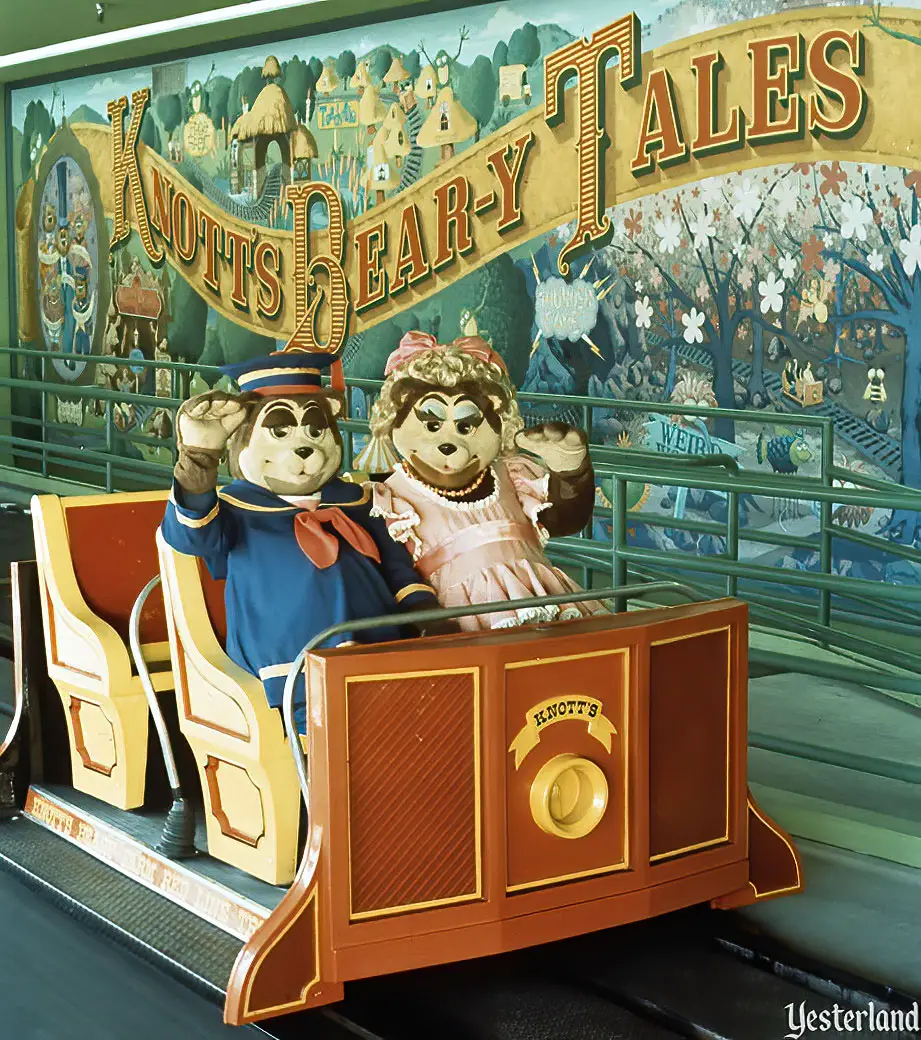
Courtesy of the Orange County Archives, from the Knott’s Berry Farm Collection Four-passeneger ride vehicles, providing a high capacity |
|||
|
CM: Speaking of earlier concepts—weren’t the trolley cars you rode in going to look different? RC: Well, what happened was that Dave Rudderow decided that it should be a streetcar. Which was kinda cute, but he wanted to put a top on it. And I said, “No. If you put a top on it, you’ll block a lot of what we’re trying to achieve visually.” So, I made him take the top off. But it’s basically a streetcar—that’s why there’s the little headlight in front. But I don’t think anyone paid any attention to what it was or where it was going. CM: Tell us about your son Christopher and his construction of the Chug-A-Chug. RC: See, I knew that Chris was an excellent carpenter. He understood how to work with me—I’d give him a sketch and he’d build it from that! So, when Fantasy Fair started, I asked him to come work with us. So, I assigned him to begin with—to do the Chug. Steve Kirk actually did a little model of it, and with that tiny model, that’s what Chris used to build the Chug… CM: Was there any other model work done? RC: Well, there was one that Dave Rudderow and the kids did for him, but we couldn’t use it. Once we got in the building, we couldn’t build anything of that size or scope. But, it was a good selling point to show the Knott family what it would look like in different areas. CM: So, the Bear-y Tales opened on July 4th, 1975—after only 9 months of work… RC: Yes. I’d say it was actually more like 6 months—not 9. Because I came back from Florida in July of 1974, and didn’t start on it until September. So, that’s about right, because we had that fire y’know… CM: Why don’t you talk a little about that. RC: Tommy O’Neil had a non-union shop. And he thought that it wouldn’t be wise for them to start installing the building until the union people were done putting that together. Knott’s had hired a union contractor to build it. But they said, “It’ll be O.K.—don’t worry about it.” Well, we installed about 50% of the ride—and all of a sudden—they just lit it up! Well, the fire department brought in an arsonist, and he said that it was a very professional job. It had started in five places at the same moment. So, it just went up in flames, and that was kinda sad… CM: So, how much time did you have left at that point? RC: Oh, not a lot! I think we got a six-week extension! It took Chris 3 months to build the Chug the first time—because he did it from scratch—and the next one he did in 6 weeks! So it was an interesting time frame… |
|||
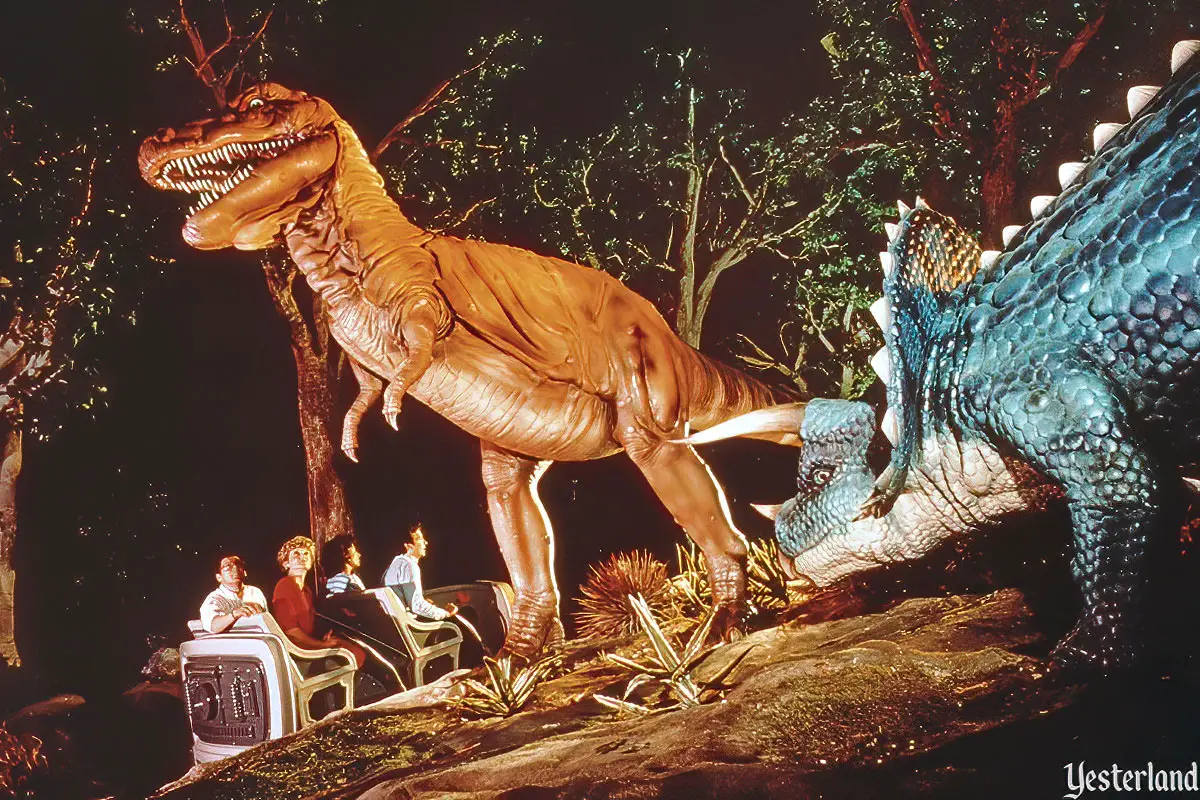
Courtesy of the Orange County Archives, from the Knott’s Berry Farm Collection Bear-y Tales’ replacement, Kingdom of the Dinosaurs (1987-2004), using the same trolleys |
|||
|
CM: What are your memories about opening night for the Roaring 20s area? RC: Well, we all went and—God! The food was wonderful! Knott’s really does have the best food in the world. I also remember, we were all a little worried about going on the Corkscrew—but we all went and fell in love with it. We just kept going on it! It was a great party… You know, the Bear-y Tales was something we all really enjoyed. And not only did we design it, we installed it too! We worked night and day, until 2 or 3 in the morning. And we’d get 3 or 4 six-packs and some hamburgers, and have a party in the ride! (LAUGHTER) Well, for six weeks after the ride opened, I went down every other night at 3 o’clock in the morning, and worked with the maintenance crew to correct things that might be going wrong. Do you know what those guys did one night? They actually put a ladder on one of the cars, and turned on the ride to carry it through! Well, the car made a turn, and the ladder just kept going—it stuck and went right through the sets in the wall, and jammed the ride! (LAUGHTER) But the bottom line of it was that it was a wonderful project, and I enjoyed doing it. The kids who worked with me loved it, and the best part is—people have come up to me and said, “Wow, the Bear-y Tales—you did that? We loved it!” And that always made me feel good. |
|||
|
Chris Merritt’s Knott’s Bear-y Tales Fun Map |
|||
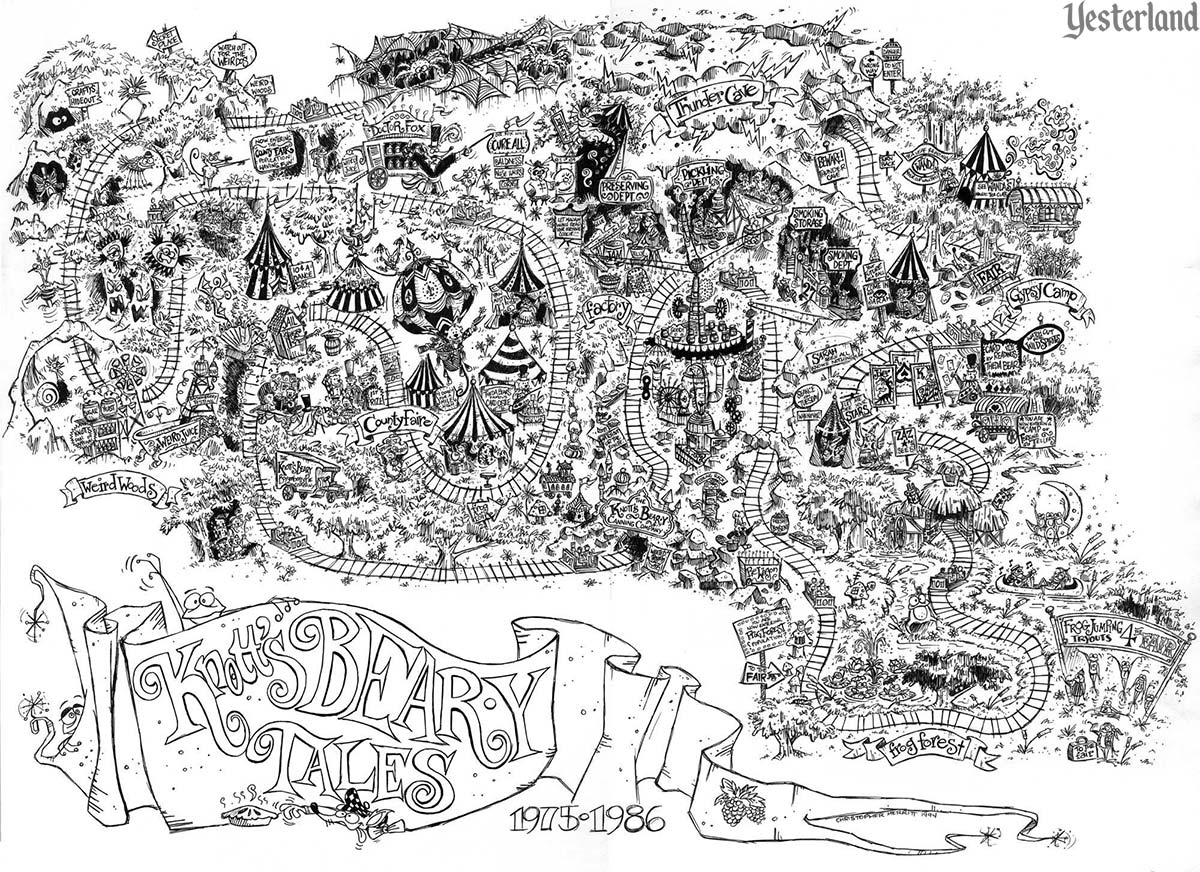
Knott’s Bear-y Tales “fun map” © 1994 Christopher Merritt Click here or on the image above for a much larger version |
|||
|
About the Interviewer and Artist |
|||
|
Southern California native Christopher Merritt has more than twenty years of attraction and show design experience creating theme park attractions and environments around the world as an art director and production designer at theme parks located in California, Florida, Tokyo, Singapore, and Shanghai. Chris is the author of a Knott’s Berry Farm pictorial history, Knott’s Preserved (2010) and Pacific Ocean Park: The Rise and Fall of Los Angeles’ Space Age Nautical Pleasure Pier (2014). Chris’ most recent book is Marc Davis in His Own Words: Imagineering the Disney Theme Parks (2019), co-authored with Pete Docter. Chris spent countless hours with Marc Davis (and Alice Davis)—both learning from the masters and documenting history. Chris recently worked as lead show designer for the Tokyo DisneySea version of the Frozen attraction for Walt Disney Imagineering. |
|||
|
Knott’s Preserved:
Knott’s Preserved, was reviewed here on March 19, 2010. The original edition described in this review is out of print and sold out. In 2015, authors Christopher Merritt and J. Eric Lynxwiler and publisher Angel City Press released a 176-page revised and expanded second edition.
Knott’s Preserved [Revised Edition] (2015), hardcover, from Amazon |
|||
|
Yesterland is a participant in the Amazon Services LLC Associates Program, an affiliate advertising program designed to provide a means for sites to earn advertising fees by advertising and linking to Amazon. That means Yesterland benefits financially if you buy this book (and any other items at Amazon) using a link in this article. |
|||
|
|
Interview © 2001 Christopher Merritt Yesterland website © 2023 Werner Weiss — Disclaimers, Copyright, and Trademarks Updated April 13, 2023 |
||